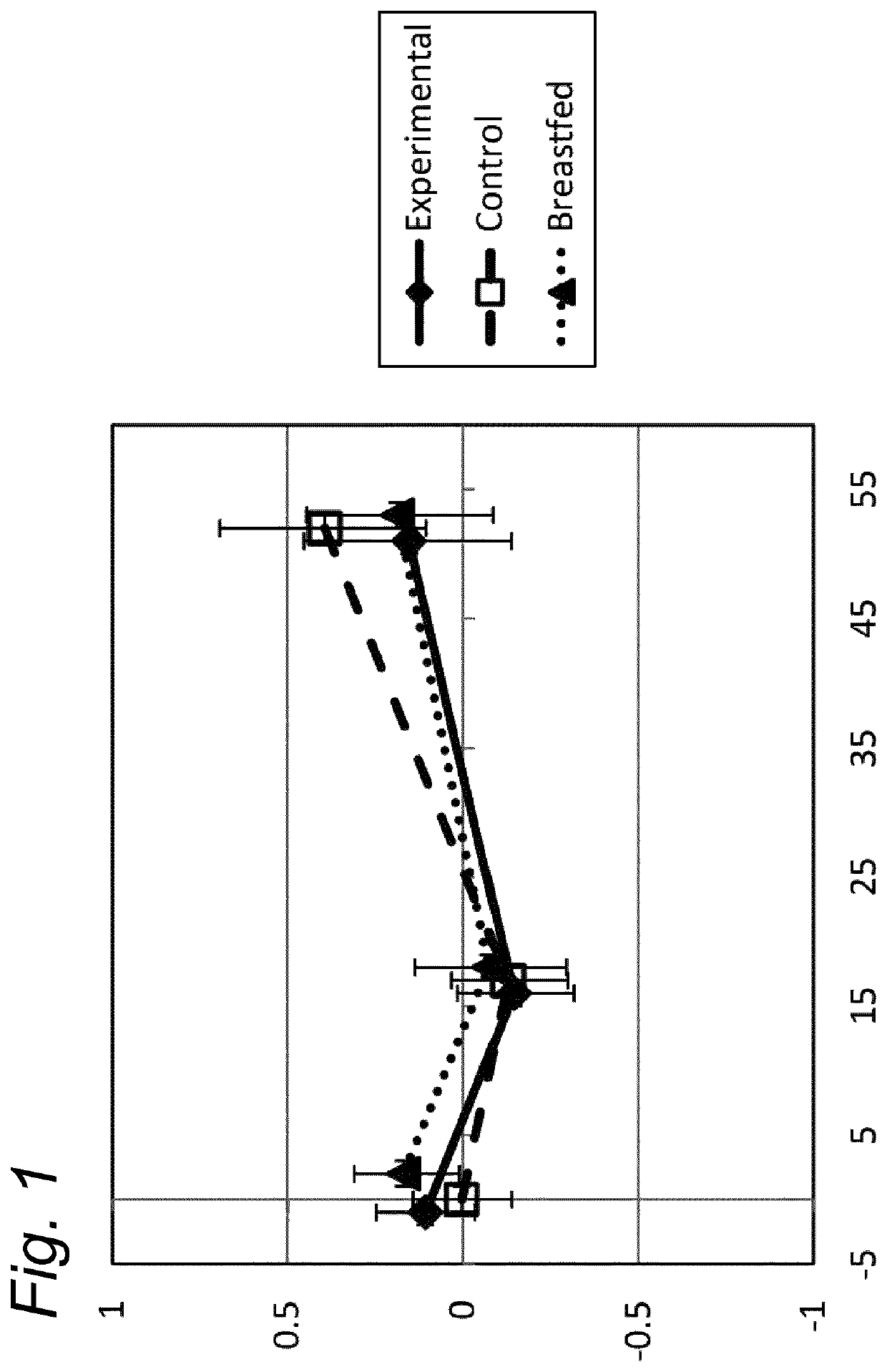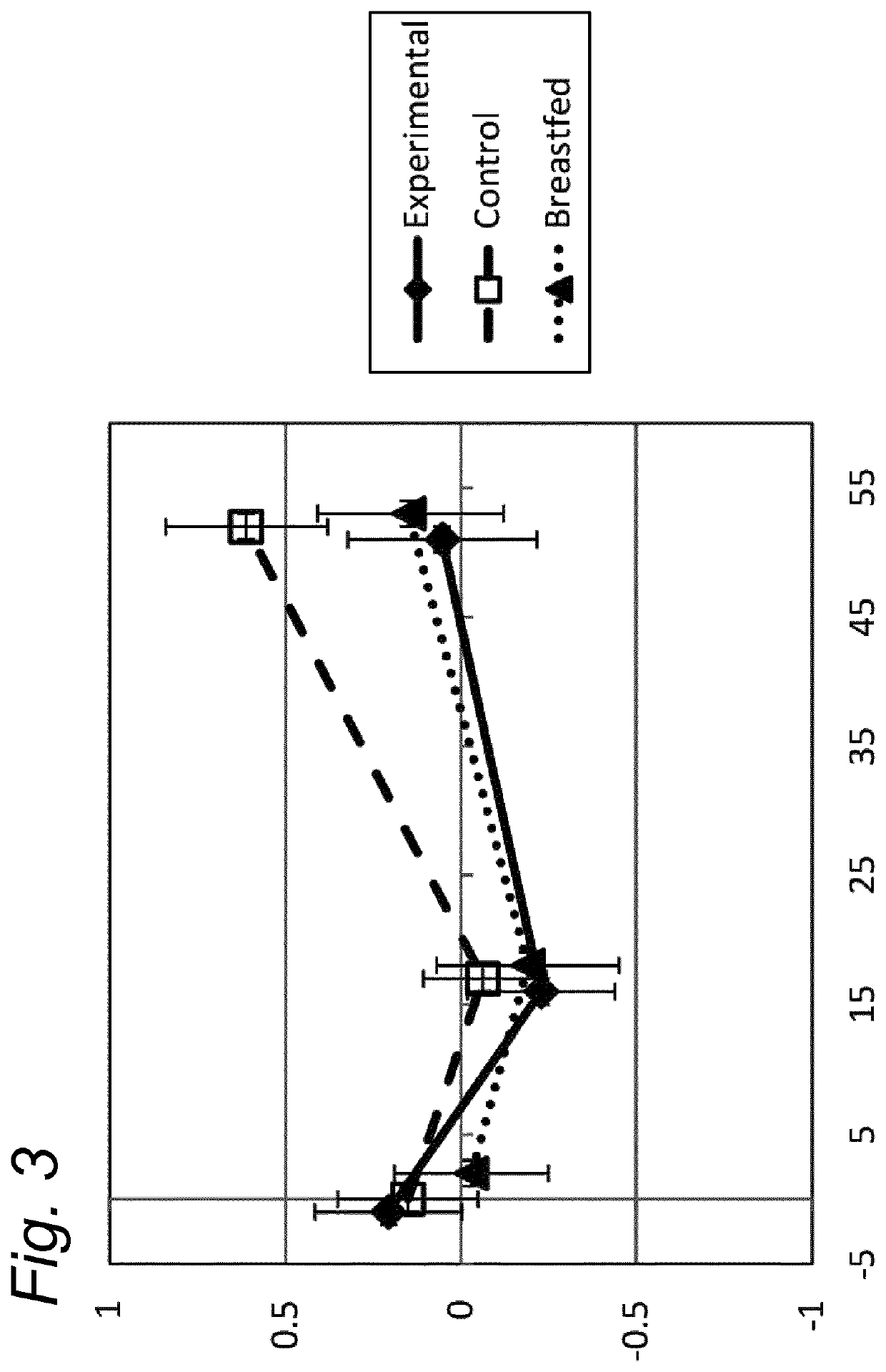Infant formula with special lipid architecture for promoting healthy growth
a technology of lipid architecture and infancy formula, applied in the direction of peptide/protein ingredients, unknown materials, plant/algae/fungi/fungi/lichen ingredients, etc., can solve the problems of inadequate or unsuccessful breast feeding
- Summary
- Abstract
- Description
- Claims
- Application Information
AI Technical Summary
Benefits of technology
Problems solved by technology
Method used
Image
Examples
example 1
tal and Control Formula
Diet 1: Standard Nutrilon 1
[0085]An infant formula with per 100 ml ready to drink formula 66 kcal, 1.3 g protein (whey protein and casein in a 6 / 4 w / w ratio), 7.3 g digestible carbohydrates (mainly lactose), 3.4 g fat and 0.8 g short chain galacto-oligosaccharides (source VivinalGOS) and long chain fructo-oligosaccharides (source RaftilinHP) in a 9 / 1 w / w ratio, and minerals, vitamins trace elements and other micronutrients as known in the art and in compliance with directives for infant formula. The formula is provided as a powder with the instruction to reconstitute with water. About 13.6 g powder was reconstituted to 100 ml ready to drink infant formula.
[0086]The lipid globules had a mode diameter, based on volume, of about 5.6 um, and the volume % of lipid globules with a mode between 2 and 12 μm was above 45.
[0087]The fat component comprised mainly vegetable fat (blend of palm oil, low erucic acid rape seed oil, coconut oil, high oleic sunflower oil, sunfl...
example 2
tocol and Study Population
[0091]After parent(s) / legal guardian(s) have signed informed consent, exclusively formula fed infants eligible for participation were randomised to receive either the experimental product or the control product for a double-blind period of maximally 17 weeks (depending on their age at study entry). Exclusively breastfed infants participated in the reference group and had the same visit schedule and study assessments as the randomised infants. At the first visit, baseline and birth data were collected, and the study product and diaries were provided to the parent(s). Further study visits were conducted at 5, 8, 13 and 17 weeks of age. Information and anthropometrical measurements were collected during the visits. During the visit at 52 weeks (an optional extension of the study), anthropometrical measurements were collected. 4 countries with 17 sites participated, and in total 313 subjects were enrolled; 6 sites in the Netherlands (121 subjects), 3 sites in F...
example 3
rowth Trajectories and Body Development
Weight
[0101]The median weight (kg) of boys and of girls (included in the three study groups) was shown to be well within the z-score of −1 and +1 of the WHO Child growth standard z-scores, for the ITT and for the PP dataset (data not shown).
[0102]The weight gain per day in the experimental group was equivalent compared to the breastfed reference group (post hoc analysis) from visit at baseline until the age of 17 weeks, in the PP as well in the ITT datasets, using an equivalence margin of ±3 g / day. Equivalence of weight gain per day was demonstrated for the experimental formula compared to standard formula group (PP and ITT population), even when only selecting infants enrolled before 14 days of age.
[0103]The mean weight-for-age z-scores per visit and the corresponding 95% Confidence intervals (CI), showed that the growth in weight of the breastfed reference group was not different from the WHO Child growth standards. Between baseline and 13 we...
PUM
| Property | Measurement | Unit |
|---|---|---|
| diameter | aaaaa | aaaaa |
| diameter | aaaaa | aaaaa |
| wt. % | aaaaa | aaaaa |
Abstract
Description
Claims
Application Information
 Login to View More
Login to View More - R&D
- Intellectual Property
- Life Sciences
- Materials
- Tech Scout
- Unparalleled Data Quality
- Higher Quality Content
- 60% Fewer Hallucinations
Browse by: Latest US Patents, China's latest patents, Technical Efficacy Thesaurus, Application Domain, Technology Topic, Popular Technical Reports.
© 2025 PatSnap. All rights reserved.Legal|Privacy policy|Modern Slavery Act Transparency Statement|Sitemap|About US| Contact US: help@patsnap.com



